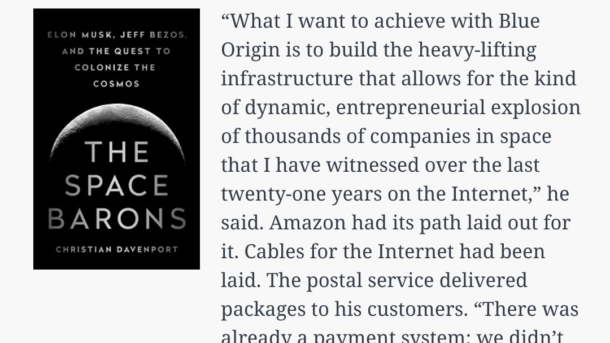“If you take baseline energy usage today, compound it at just a few percent a year for just a few hundred years and you have to cover the entire Earth’s surface with solar cells” to keep up with demand, he said. “You either go out into space or you need to control population on Earth. You need to control energy usage on Earth. These things are totally at odds with a free society. And it’s going to be dull. I want my great-great-grandchildren to be using more energy per capita than I do. And the only way they can be using more energy per capita than me is if we expand out into the solar system. And then we can really keep Earth as this incredible gem that it is.” Blue Origin’s oft-repeated goal was “millions of people living and working in space.” But over the long term, it was even more ambitious than that. “If we want, we could have a trillion human beings living in the solar system,” he said during an awards ceremony in Washington. “And then we’ll have a thousand Einsteins, and a thousand Mozarts. What a cool civilization that would be.” When he started Amazon, the infrastructure was already in place so that a startup Internet company, even in 1995, could be successful. Now he wanted to start building the transportation network to space. While he had been inspired by the achievements during the Apollo era, the country’s human spaceflight program had “been treading water for a long time,” he said. And during an interview at the Vanity Fair “New Establishment Summit,” he sounded very much like Musk, speaking about creating a “cargo route” to space that would be similar to the railroads that opened up the West. “What I want to achieve with Blue Origin is to build the heavy-lifting infrastructure that allows for the kind of dynamic, entrepreneurial explosion of thousands of companies in space that I have witnessed over the last twenty-one years on the Internet,” he said. Amazon had its path laid out for it. Cables for the Internet had been laid. The postal service delivered packages to his customers. “There was already a payment system; we didn’t have to do that,” he said. “It was called the credit card, and it had been initially put in place for travelers.” All Amazon had to do then was “take that infrastructure and kind of reassemble it in a new way, and do something new and inventive with it.… In space today, that is impossible. On the Internet today, two kids in their dorm room can reinvent an industry, because the heavy-lifting infrastructure is in place for that. Two kids in their dorm room can’t do anything interesting in space.” He wanted, then, to use his vast fortune to lay the foundation of that infrastructure into space. To make that part of his legacy. “If I’m 80 years old and I’m looking back on my life,” he said during an awards ceremony, “and I can say that I put in place, with the help of the teammates at Blue Origin, the heavy-lifting infrastructure that made access to space cheap and inexpensive so that the next generation could have the entrepreneurial explosion like I saw on the Internet, I’ll be a very happy 80-year old.”
We’re at the forefront of witnessing the early development of infrastructure for the space industry. I find this really exciting and can’t wait to see how it goes.
I also begin to think about the flip side perspective that I have sometimes seen from social media comments. Why should we even bother with space when we can’t even get things right in our own planet. And while some elements of that is true, in that we can definitely do better in solving shit in our very own planet, its becomes dangerous whenever we begin to view things in binary terms and as a zero sum game.
It doesn’t mean that we shouldn’t embark on endeavours that cannot yield direct, obvious benefits. Many times, the we can’t foresee how innovation and development and they can come from various angles and it usually makes sense to decentralise things a little and allow for people to pursue a wide range of objectives. And interestingly enough, a quick Wikipedia search shows that LASIK technology came from NASA’s efforts in the 1980s for autonomous rendezvous and docking of space vehicles to service satellites.



